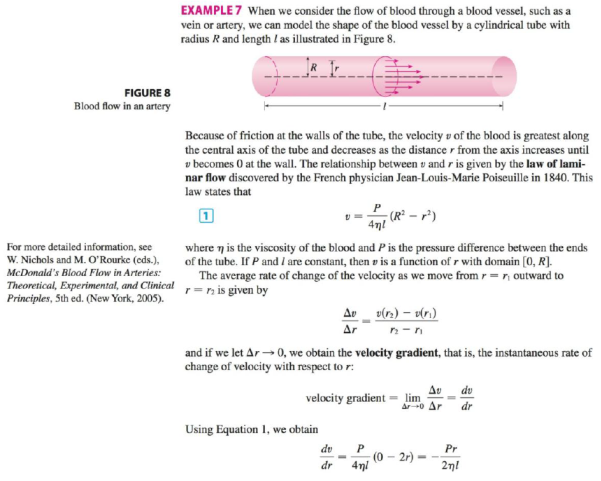
Concept explainers
Refer to the law of laminar flow given in Example 7. Consider a blood vessel with radius 0.01 cm, length 3 cm, pressure difference 3000 dynes/cm2, and viscosity η = 0.027.
(a) Find the velocity of the blood along the center-line r = 0, at radius r = 0.005 cm, and at the wall r = R = 0.01 cm.
(b) Find the velocity gradient at r = 0, r = 0.005, and r = 0.01.
(c) Where is the velocity the greatest? Where is the velocity changing most?
EXAMPLE 7


(a)
To find: The velocity of the blood along the center line
Answer to Problem 27E
Velocity of the blood along the center line is
Velocity of the blood at 0.005cm as radius is
Velocity of the blood at the wall is
Explanation of Solution
Given:
The law of laminar flow is as given below.
The length of the blood vessel is given below.
The pressure difference between the ends of the vessel is given below.
The viscosity of the blood is given below.
Calculation:
Calculate the velocity of the blood along the center line using the equation (1).
Substitute 3cm for
Thus, the Velocity of the blood at
Calculate the velocity of the blood at
Substitute 3 cm for
Thus, the Velocity of the blood at
Calculate the velocity of the blood at the wall using the equation (1).
Substitute 3 cm for
Thus, the Velocity of the blood at
(b)
To find: The velocity gradient at
Answer to Problem 27E
Velocity gradient at
Velocity gradient at
Velocity gradient at
Explanation of Solution
Calculate the velocity gradient at center line
Differentiate equation (1) with respect to
Substitute 3 cm for
Thus, the Velocity of the blood at radius
Calculate the velocity gradient at
Substitute 3 cm for
The velocity gradient at
Calculate the velocity gradient at the wall edge
Substitute 3 cm for
The velocity gradient at
(c)
To find: Where is the velocity the greatest and where it changes the most.
Answer to Problem 27E
The velocity is greatest where
Explanation of Solution
The velocity is greatest where
Chapter 3 Solutions
Single Variable Calculus: Concepts and Contexts, Enhanced Edition
Additional Math Textbook Solutions
Precalculus Enhanced with Graphing Utilities (7th Edition)
University Calculus: Early Transcendentals (3rd Edition)
Calculus: Early Transcendentals (2nd Edition)
Precalculus: Concepts Through Functions, A Unit Circle Approach to Trigonometry (4th Edition)
Thomas' Calculus: Early Transcendentals (14th Edition)
Precalculus
 Calculus: Early TranscendentalsCalculusISBN:9781285741550Author:James StewartPublisher:Cengage Learning
Calculus: Early TranscendentalsCalculusISBN:9781285741550Author:James StewartPublisher:Cengage Learning Thomas' Calculus (14th Edition)CalculusISBN:9780134438986Author:Joel R. Hass, Christopher E. Heil, Maurice D. WeirPublisher:PEARSON
Thomas' Calculus (14th Edition)CalculusISBN:9780134438986Author:Joel R. Hass, Christopher E. Heil, Maurice D. WeirPublisher:PEARSON Calculus: Early Transcendentals (3rd Edition)CalculusISBN:9780134763644Author:William L. Briggs, Lyle Cochran, Bernard Gillett, Eric SchulzPublisher:PEARSON
Calculus: Early Transcendentals (3rd Edition)CalculusISBN:9780134763644Author:William L. Briggs, Lyle Cochran, Bernard Gillett, Eric SchulzPublisher:PEARSON Calculus: Early TranscendentalsCalculusISBN:9781319050740Author:Jon Rogawski, Colin Adams, Robert FranzosaPublisher:W. H. Freeman
Calculus: Early TranscendentalsCalculusISBN:9781319050740Author:Jon Rogawski, Colin Adams, Robert FranzosaPublisher:W. H. Freeman
 Calculus: Early Transcendental FunctionsCalculusISBN:9781337552516Author:Ron Larson, Bruce H. EdwardsPublisher:Cengage Learning
Calculus: Early Transcendental FunctionsCalculusISBN:9781337552516Author:Ron Larson, Bruce H. EdwardsPublisher:Cengage Learning





